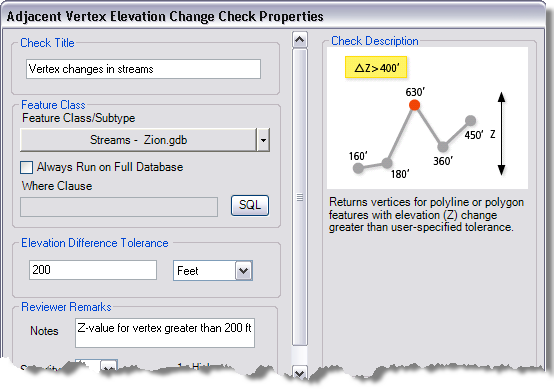Disponible avec une licence Data Reviewer.
When performing quality control checks on your database, one of the items to search for is a significant difference in elevation, which is represented as the z-value. For example, within a contour feature class, the z-value for a given contour should be constant for all vertices. However, on occasion, there are outlying vertices with different z-values.
The Adjacent Vertex Elevation Change check searches for polyline and polygon features with vertices that have elevation differences (z-values) greater than a specified tolerance. The tolerance helps you to find any significant gaps between feature elevations. The check can be run on an entire feature class, subtype, or set of features selected using a SQL query. The features that fall outside of the specified tolerance, or have a difference that is greater than the value specified, are returned as check results. These features can then be written to the Reviewer table for further inspection and correction.
Once you have defined the criteria for the check, you can configure the notes and a severity rating. The notes allow you to provide a more specific description for the feature that has been written to the Reviewer table and are copied to the Notes field in the Reviewer table. The severity rating allows you to indicate how important the results from a check are in terms of your quality assurance/quality control processes. The lower the number, the greater the priority the check's results have.
- Start ArcMap.
- On the main menu, click Customize > Toolbars > Data Reviewer.
- Click the Select Data Check drop-down arrow on the Data Reviewer toolbar, click the plus sign (+) next to Z Value Checks, then click Adjacent Vertex Elevation Change Check.
The Adjacent Vertex Elevation Change Check Properties dialog box appears.

- If necessary, type a unique name for the check in the Check Title text box.
- Click the Feature Class/Subtype drop-down arrow to choose the feature class and subtype on which to run the check.
This is the feature class that contains the z-values you want to evaluate.
- To run the check on the entire feature class and save this setting, check the Always Run on Full Database check box.
- To run the check on specific features in a feature class, click SQL to construct an SQL query.
- Type the number of units to use for the tolerance in the Elevation Difference Tolerance text box.
- Click the Elevation Difference Tolerance drop-down arrow to choose the units to use for the tolerance.
You can choose from both page units and map units. Page units include points, centimeters, inches, and millimeters. Map units include feet, yards, miles, nautical miles, meters, kilometers, decimal degrees, and decimeters.
- If necessary, type descriptive text for the check results in the Notes text box in the Reviewer Remarks area.
- If necessary, click the Severity drop-down arrow and choose a value that indicates the priority of the check's results in the Reviewer Remarks area.
The severity indicates the importance of the check result. The values range from 1 to 5, with 1 being the highest priority and 5 being the lowest.
- Cliquez sur OK.
- Click the Run Data Check button
 on the Data Reviewer toolbar.
on the Data Reviewer toolbar.
The Features to Validate dialog box appears.

- Choose an option in the Features to Validate area.
- Selection Set—The check is run on the features that are currently selected in the map.
- Current Extent—The check is run on the current map extent, which is controlled by the map scale.
- Definition Query—The check is run on the features that are displayed based on definition queries that have been created for the feature class.
- Full Database—The check is run on all the features in the feature class.
- To run the check only on features that have been edited in a versioned workspace, check the Changed Features Only check box.
- Click OK.
The check is run on the extent specified on the Features to Validate dialog box.
When the check finishes, a check results dialog box appears.
- Do one of the following:
- If you want to browse the results in the Browse Features window, choose the Browse Results option.
- If you have started a Reviewer session and want to record the results in the Reviewer table, choose the Write to Reviewer Table option.
- Cliquez sur OK.